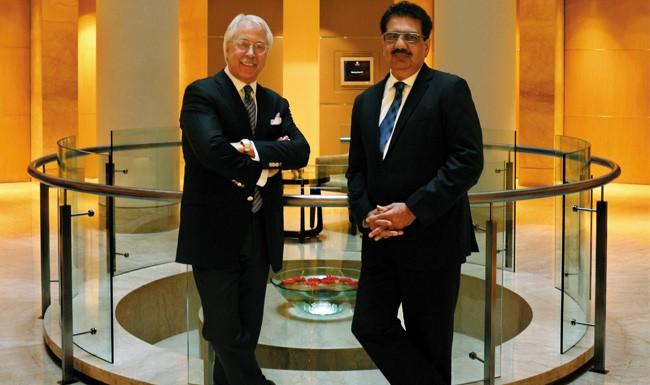"India Inc Must Move To The Forefront Of Creative Destruction"

The Inspiring India series, hosted by Vineet Nayar, former HCL CEO and founder of Sampark Foundation and Gary Hamel, the world’s leading business thinker, was held earlier this year to drive business practitioners to think about leapfrogging global companies trapped in old, obsolete organisation architecture. The two stalwarts believe that India Inc can create a competitive advantage for itself if it reinvents management and inspires a generation of young Indians to think about leadership in a more human way. They speak to Meghna Maiti about growth and entrepreneurship and how the corporate sector should transform into creative set-ups to contribute to this growth story
How much of our future economic growth is dependent on Modi? Or rather, government policy?
Nayar: Certainly a lot but fortunately, not all! The growth is irrespective of the government since India Inc has existed in all kinds of circumstances. While on the one hand, we have a strong public-private growth partnership as an example of economic prosperity in South Korea, on the other hand, we also have equally successful examples of economies such as Germany and the US who owe their prosperity more to an ambitious group of enterprises than simply to government policy. So, yes, we do need a positive enabling environment. However, what we need more are bigger dreams, bolder actions and companies that are the world’s best in what they do.
How much of the growth will be governed by the external environment and how currencies behave? And how much of it do you think can come despite the government and global environment — purely through micro-firm level innovations and effort?
Nayar: When a diamond cutter looks at a rough diamond, he sees an opportunity. And it is so, too, with a potter, who gets excited seeing dirty clay. Great opportunities are born out of scarcity or adversity, like the $50 billion Indian IT industry, which gained significant market share during the recession. The headwinds are strong and thus we cannot depend on our growth to mirror global economic growth. We have to see an opportunity in global corporations struggling to come to terms with this new reality. While we don’t have to deal with the legacy they have, we could come up with innovative propositions that will shift a substantial market share away from the existing players. Great corporations such as Amazon, Google, Apple and Facebook are never too concerned about the external environment as they have learnt to create demand where none exists and that’s the mantra I believe Indian enterprises need to embrace.
What’s missing in the entrepreneurship ecosystem in India? Is there a way to plug it quickly or will it take its own time coming?
Nayar: Our education system is not that great — it produces less independent-thinking people. Most of them submit to authority. They suddenly discover they have more capability than what they believed. However, for the first time in India, risk appetite has improved significantly. Angel investors have come in, mentors have come in, along with all the elements which require you to be a successful entrepreneur.
How far are we from seeing a Facebook, Twitter or Uber coming from India?
Hamel: Around ten years. I believe that the next generation of Indian entrepreneurs will have global aspirations.
Is technology going to be a key driver for the big leap here on?
Hamel: Yes, definitely.
How do you prepare a company to transform from a traditional corporate power structure to a creative organisation? What kind of adjustments do companies have to make for this shift?

Hamel: If you want to transform a company from a traditional, hierarchical structure to a creative, network-centric organisation, you need employees who bring their creativity to work. Every business today competes in an ecosystem with partners, suppliers, joint ventures, etc. No company competes on its own. Companies have to be more innovative, more adaptable and more inspiring to people. The organisations should be as inspiring and inventive as the individuals who inhabit them. They would have to re-engineer their management models. Old management models are a mash-up of several management ideas — military command structure, principles of engineering — none of which enables innovation, adaptability and passion. This comes from experimentation, risk-taking, prototyping and even a certain amount of waste when you think about new ideas. To be adaptable and innovative at their core, companies need to borrow principles from systems that are already resilient and creative, like the internet, biology, cities and free markets.
We require a large number of inspired management innovators — individuals who could envision and test radical alternatives to the management status quo. Traditional approaches to improving management practices are simply too slow. What is needed instead is a broad portfolio of bold, yet low-risk management experiments.
What are the challenges to this transformation?
Nayar: The aspiration is missing in the organisations. Each one of us could be ten times of what we are, but the aspiration level and management structure has to improve dramatically. We need to ask ourselves these questions: is our innovation structure better than what happens at the bottom of the pyramid at Godrej or Nestle? Are we creating followers or leaders? Do we have mass-scale people? Are we creating instruction-led managers, and are we creating aspiration-based, empowered and inspired employees?
These days, a lot of IITians are joining creative start-ups such as Flipkart, Jabong, etc. Hence, the creme de la creme of our country is joining smaller firms. The large companies would have to create a completely different organisational culture to keep attracting talent.
Hamel: I don’t think any organisation ever outperforms its aspirations. They might start with limited resources and huge aspirations, but over time, as they succeed, resources catch up with aspirations. Aspiration is not usually financial, it’s about the difference you want to make in the world. Creativity is the gap between resources and aspirations. Creativity comes when your resource is spent and aspiration is high, so organisations should jump up their aspiration so much that their resources seem inadequate.
How does this creative organisational structure fit into the Indian context? How plausible is it here, given that hierarchy is inherently part of our culture?
Nayar: We are now in a $2 trillion economy. If we continue to grow at the current rate of growth, we will get to $10 trillion in 25 years. Now, how do you get there in 10 years? How do we inspire people and leaders to reach there? That is the premise of the Inspire India movement.
With the advent of digitisation, boundaries are blurring and divides are vanishing. New entrants such as Skype, Instagram and WhatsApp are challenging the old ways of doing things. Old management models are becoming obsolete. This is the first time in history that India Inc has the opportunity to grow 5x in 5 years. To do that, we need to get our
innovation models right way before anybody gets there. We need to be innovative in our management structure. India has the opportunity to create a services industry. With the advent of digitisation, we could create entrepreneurial companies and inspire traditional companies to entirely re-invent themselves.
Indian organisations need to change their strategies and the management needs to spend time on disruptive innovation. If you do that, then the employees need to spend significant time on incremental innovation, which is innovation at the edge by creating new experiences and unique products, while the management should focus on disruptive innovation with breakthrough ideas. Then, Indian organisations can become the global number one.
Do you expect this shift to be gradual or will challengers thrust this upon the bigger, traditional organisations?
Hamel: In our highly dynamic world, it’s not enough for an organisation to possess a competitive advantage at a point in time — it also needs an evolutionary advantage over time, a capacity to change as fast as change itself, and to do so without the pressure of a looming performance crisis. All too often, deep change is belated and convulsive, rather than proactive and energising — it comes after an organisation has failed to negotiate a turn on the road to the future, and has spun off into a ditch.
How would the organisations measure discipline and focus in such a set-up? How would performance get measured?
Hamel: Most managers believe freedom and discipline are mutually exclusive, that control must be exercised from above, that people will reflexively resist change, and that first-level associates are incapable of self-management. However, I believe, its possible to kill hierarchy without endangering the discipline and focus that will always be essential to organisational success. Organisations could always find out ways to maintain a spirit of creativity in a fairly disciplined environment. I have been developing an audaciously new approach to management innovation — one where performance management systems overweight medium-term innovations and underweight short-term operational goals. Compensation systems should over-reward courageous risk-takers and under-reward politically savvy apparatchiks. Performance should also be based on passion, creativity, innovative thinking, fresh ideas and experimentation.
Nayar: Indian companies have to move away from the Hindu rate of growth. They have to create completely new market spaces. Sun Pharma’s acquisition of Ranbaxy is a great example where an Indian company sees exponential growth.
Could you name some innovative companies in India?
Nayar: Significant innovation is coming from digital companies such as Snapdeal, Ola, Street Sherpa in tourism and Mu Sigma in digital. In management structure innovation, we see HCL treating its customers as family, HUL and Godrej show innovations at the bottom of the pyramid, Nestle in the way it handles the nutrition problem, GE’s incubation — they are recreating the organisation structure so that they can create innovation at
the edges.

